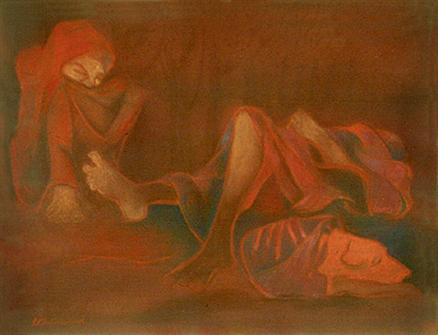 Krishen Khanna is
one of the distinguished names in the Indian
contemporary art scenario. Along with his friends
M.F. Husain, Tyeb Mehta, Ram Kumar, Raza, Souza,
Gaitonde and others; Khanna started painting at a
time when there was not much glitz in art. He was
born in pre partition India in 1925 in the Lyallpur
district (now in Pakistan). He then moved to Shimla
during the partition era. In Lahore, Khanna attended
evening classes at the Mayo School of Art. After
coming to India, he took up a job with Grindlays
Bank and was placed in Mumbai. But he gave up a job
in Grindlays Bank to pursue art about four decades
ago. During that time the art scenario was much
different and enclosed than what it is now. His
ardor for art motivated him to take such a step. His
hard work, perseverance and interest won him many
rewards and accolades in the art world. Krishen
Khanna has also taught art in the United States
without any formal academic qualification in the
subject. The artist's sympathy towards the
browbeaten and poor people is vivid in his
paintings. . Depiction of violence and can also be
seen in Khanna’s work coming from his experiences
during the Partition.
Krishen Khanna is
one of the distinguished names in the Indian
contemporary art scenario. Along with his friends
M.F. Husain, Tyeb Mehta, Ram Kumar, Raza, Souza,
Gaitonde and others; Khanna started painting at a
time when there was not much glitz in art. He was
born in pre partition India in 1925 in the Lyallpur
district (now in Pakistan). He then moved to Shimla
during the partition era. In Lahore, Khanna attended
evening classes at the Mayo School of Art. After
coming to India, he took up a job with Grindlays
Bank and was placed in Mumbai. But he gave up a job
in Grindlays Bank to pursue art about four decades
ago. During that time the art scenario was much
different and enclosed than what it is now. His
ardor for art motivated him to take such a step. His
hard work, perseverance and interest won him many
rewards and accolades in the art world. Krishen
Khanna has also taught art in the United States
without any formal academic qualification in the
subject. The artist's sympathy towards the
browbeaten and poor people is vivid in his
paintings. . Depiction of violence and can also be
seen in Khanna’s work coming from his experiences
during the Partition.Khanna sold his first painting in a major exhibition in to Dr. Homi Bhabha for the Tata Institute of Fundamental Research. His father always encouraged and supported him to pursue art as a career. In fact his wife also supported him when he resigned from the job. Khanna shows and exhibitions in Mumbai were very well received and this boosted up his confidence. Khanna was also invited to join the Progressive Artists' Group with whom he remained involved for the rest of his time.
In 1962,
Khanna was awarded the ‘Rockefeller Fellowship’. In
1963-64, he was ‘the Artist in Residence’ at the
American University in Washington. Apart from
several solo shows, he has participated in group
shows like the ‘Tokyo Biennale’ in 1957 and 196 1,
the ‘Sao Paulo Biennale’ in 1960, ‘the Venice
Biennale’ in 1962, and several others. Khanna has
held many vital positions in decision-making bodies
of the Lalit Kala Academy, National Gallery of
Modern Art and Roopanker Museum, Bhopal. In 1996, he
was awarded the grand ‘Padma Shri’.
Khanna
does not prefer the cornucopia of figuration which
was so evident in Indian paintings. Khanna makes
such an incredible impact on the canvas that it sure
leaves a dint in the on-lookers heart. His masterful
maneuver of painting evokes the unmatched feelings
of human situation. The thick impasto façade of the
painting often seems like a prism through which
figures can be distinguished. Khanna relocates his
observations onto the canvas with such naturalness
and exuberance that it enhances his subject matter.
His earlier works are replicas of scenes that have
imprinted themselves on his mind during the
partition. Khanna lives and works in New Delhi.



No comments:
Post a Comment